-
Original Article04-30-2025
An assessment of total antioxidant and oxidant parameters and their correlation with embryo quality in in-vitro fertilization patients
Revista Brasileira de Ginecologia e Obstetrícia. 2025;47:e-rbgo22
Abstract
Original ArticleAn assessment of total antioxidant and oxidant parameters and their correlation with embryo quality in in-vitro fertilization patients
Revista Brasileira de Ginecologia e Obstetrícia. 2025;47:e-rbgo22
Views221Abstract
Objective:
In vitro, fertilization is the primary treatment method for infertility. Follicular fluid analysis is an approach used to optimize the results of assisted reproductive techniques. Oxidative stress represents the imbalance between the production of reactive oxygen species and their detoxification. Total Antioxidant and Oxidant Status, and Oxidative Stress Index levels are the main oxidative stress markers. This study investigated the effects of oxidative stress markers on infertility etiology, embryo quality, and success of In vitro fertilization.
Methods:
Before enrolling in the ICSI-ET cycle, participants had their FSH and LH levels assessed on the second day of the cycle. The ovarian degrees of the participants were evaluated by transvaginal ultrasonography. Participants underwent controlled ovarian stimulation using the GnRH antagonist protocol. TV-USG and serial E2 measurements were performed at appropriate intervals to follow follicular development. Follicle sizes, quantity, and endometrial thickness were recorded. Total Antioxidant and Oxidant Status, and Oxidative analyses were conducted using Rel Assay Diagnostics Assay Kits.
Results:
The average number of total oocytes in the participants was 10.25±6.66, and the average of mature M2 stage oocytes was 6.71±3.72. The average number of fertilized oocytes was 4.65±2.81. Fertilization rates were calculated as approximately 54.75±25.58%. A statistically significant positive correlation was found between embryo quality and serum Total Antioxidant Status levels (p=0.004). Similarly, a significant positive correlation was observed between embryo quality and follicular Total Antioxidant Status values (r = 0.42, p = 0.01).
Conclusion:
This study concluded that oxidative stress markers affect certain stages of the IVF treatment process.
Key-words AntioxidantsFertilization in vitroFollicular fluidInfertilityOocytesOxidantsOxidative stressSee more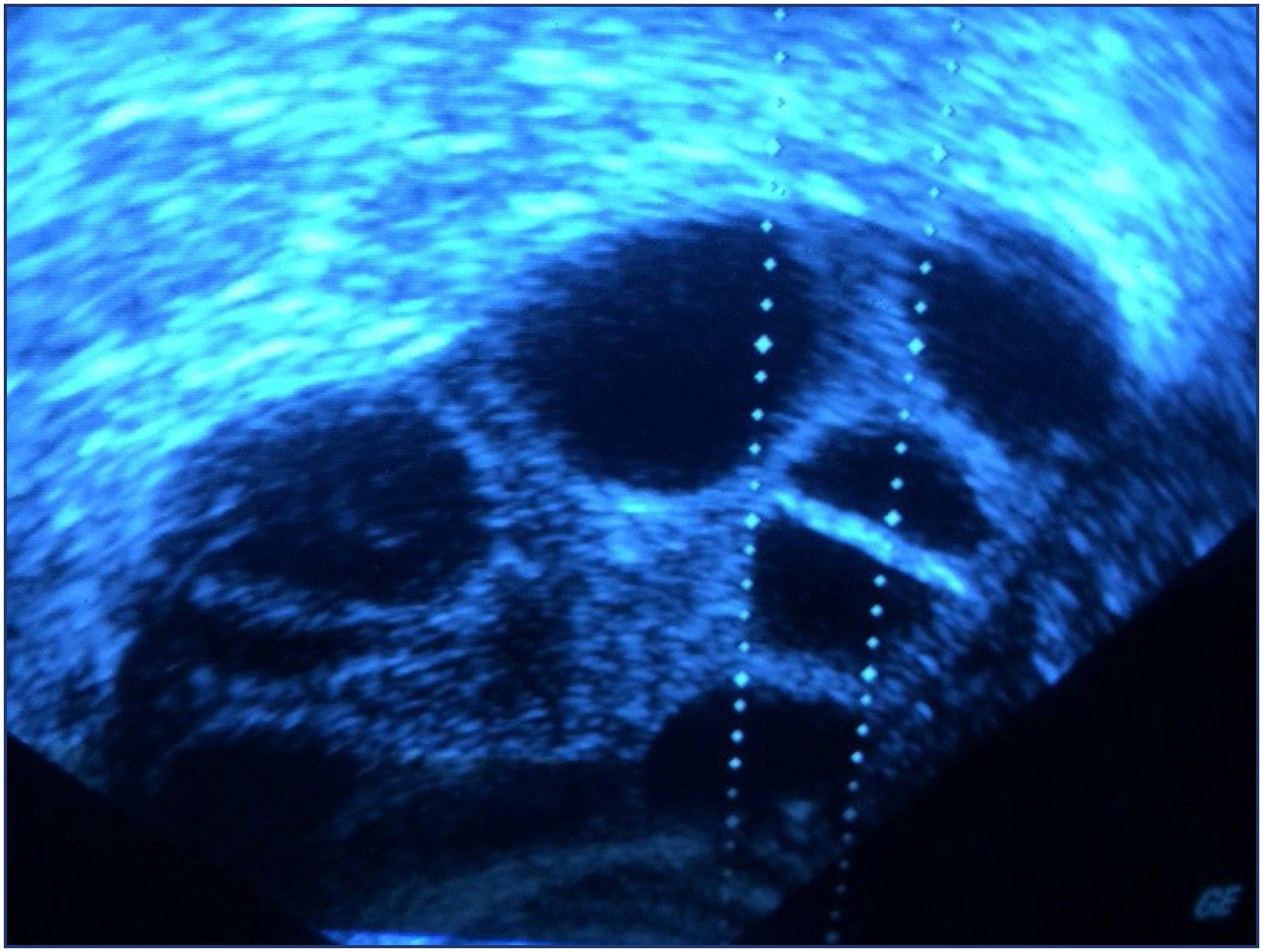
-
Review Article04-30-2025
Letrozole and clomiphene versus letrozole alone for ovulation induction in women with PCOS: a systematic review and meta-analysis
Revista Brasileira de Ginecologia e Obstetrícia. 2025;47:e-rbgo21
Abstract
Review ArticleLetrozole and clomiphene versus letrozole alone for ovulation induction in women with PCOS: a systematic review and meta-analysis
Revista Brasileira de Ginecologia e Obstetrícia. 2025;47:e-rbgo21
Views248Abstract
Objective:
We aimed to compare the efficacy and safety of letrozole and clomiphene versus letrozole alone for ovulation induction in patients with Polycystic Ovary Syndrome (PCOS).
Data Sources:
We systematically searched EMBASE, PubMed, and Cochrane databases on October 31, 2024.
Study selection:
We included studies of women with PCOS treated with a combination of clomiphene and letrozole or letrozole alone to induce ovulation that reported any of the outcomes of interest, namely rate of mature follicles and ovulation, ovulation, pregnancy, miscarriages, endometrial thickness, and number of mature follicles.
Data collection:
We pooled odds ratios (OR) and mean difference (MD) with 95% confidence intervals (CI) using a random effects model using R statistical software, version 4.2.1. Heterogeneity was assessed with I statistics, and a random effects model was used.
Data Synthesis:
Four RCTs and two observational studies comprising 592 patients were included. Combined therapy was associated with a higher rate of a mature follicle (OR 2.74; 95% CI 1.72-4.37; p< 0.001; I=0%) and ovulation (OR 2.55; 95% CI 1.57-4.12; p< 0.001; I=35.9%). The number of mature follicles, number of pregnancies, thickness of endometrial lining, and the incidence of adverse events, including headache, abdominal bloating, fatigue, back pain, breast discomfort, and night sweats, were similar between groups.
Conclusion:
In women with anovulatory infertility secondary to PCOS, letrozole and clomiphene citrate combined therapy was associated with improved mature follicle and ovulation rates, with a similar safety profile compared to letrozole alone. However, no significant impact was observed on pregnancy rates.
Key-words ClomipheneInfertility, femaleLetrozoleOvulationOvulation InductionPolycystic ovary syndromeSee more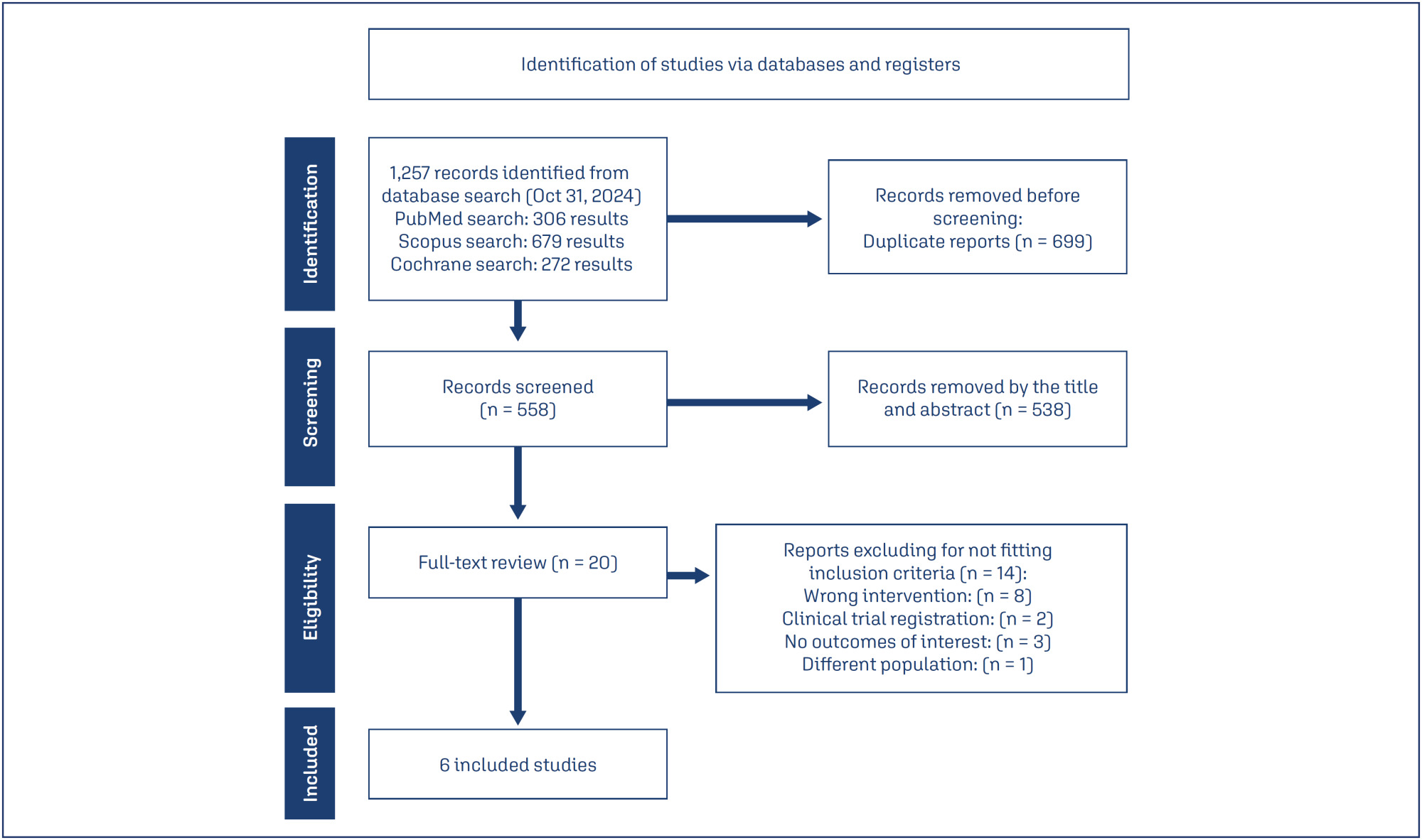
-
Original Article04-30-2025
Incidence of small-for-gestational-age newborns in pregnant women with COVID-19
Revista Brasileira de Ginecologia e Obstetrícia. 2025;47:e-rbgo20
Abstract
Original ArticleIncidence of small-for-gestational-age newborns in pregnant women with COVID-19
Revista Brasileira de Ginecologia e Obstetrícia. 2025;47:e-rbgo20
Views185Abstract
Objective:
This study aimed to assess the incidence of small for gestational age (SGA) newborns in pregnant women infected with COVID-19 and examine the associated neonatal outcomes.
Methods:
This study involved a secondary analysis of the REBRACO Network, a prospective cohort study conducted in 15 maternity hospitals in Brazil before the introduction of COVID-19 vaccination (February 2020 to February 2021). Demographic data of pregnant women tested for COVID-19 were analyzed, and fetal outcomes were compared between women with positive and negative COVID-19 results who had SGA fetuses.
Results:
A total of 729 symptomatic pregnant women with COVID-19 were included in the study. However, there were 248 participants with missing information regarding childbirth or loss of follow-up, and 107 participants without confirmatory tests for COVID-19. Among the remaining participants, 198 had confirmed COVID-19 and 176 tested negative. The incidence of SGA among women with COVID-19 was 22.4%, whereas the incidence among women who tested negative for COVID-19 was 14.8%. SGA newborns born to COVID-19 positive pregnant women were 1.6 times more likely to experience adverse outcomes (such as prematurity, stillbirth, neonatal death, and admission to a neonatal ICU) compared to non-SGA newborns [OR = 1.655 (1.145 – 2.394); P=0.017]. In SGA newborns of pregnant women with confirmed COVID-19 infection, mechanical ventilation use was found to be associated with the infection [OR = 0.692 (0.562 – 0.853); P=0.002].
Conclusion:
The higher incidence of SGA newborns and its stronger association with prematurity in pregnant women with confirmed COVID-19 infection suggest that COVID-19 infection is a significant factor contributing to neonatal morbidity and mortality.
Key-words coronavirus infectionsCOVID-19Infant, newbornInfant, small for gestational agematernal healthPregnancy complicationsSee more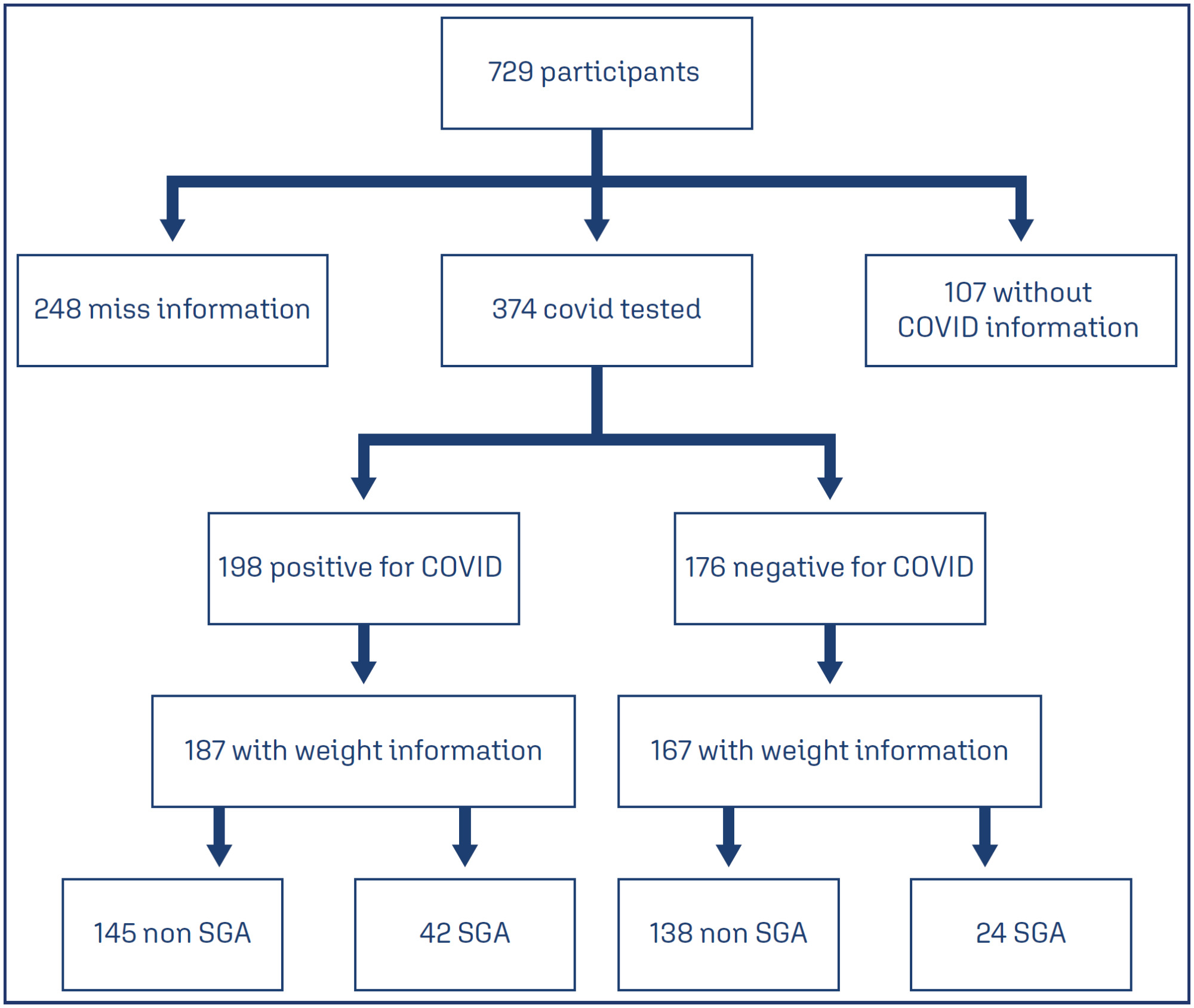
-
Review Article04-30-2025
Efficacy of tranexamic acid application in gynecology and obstetrics procedures: a umbrella review of systematic reviews of randomized trials
Revista Brasileira de Ginecologia e Obstetrícia. 2025;47:e-rbgo18
Abstract
Review ArticleEfficacy of tranexamic acid application in gynecology and obstetrics procedures: a umbrella review of systematic reviews of randomized trials
Revista Brasileira de Ginecologia e Obstetrícia. 2025;47:e-rbgo18
Views199Abstract
Objective:
This umbrella review aimed to synthesize evidence from systematic reviews of clinical trials on the efficacy of tranexamic acid in gynecology and obstetrics procedures.
Methods:
We searched Medline, Embase, SciELO and Cochrane Database of Systematic Reviews on March 11, 2024, using the term “tranexamic acid”. Four reviewers independently select studies and extract data. We assessed the quality of systematic review and the quality of evidence, using AMSTAR 2 and GRADE tools, respectively.
Results:
Of 651 systematic reviews identified, 16 reviews with 96663 patients were included. The surgical procedures were cesarean section, myomectomy, hysterectomy, and cervical intraepithelial neoplasia surgery. All reviews showed a statistically significant and clinically relevant reduction in intraoperative and post-procedure blood loss, associated with intravenous or topical use of tranexamic acid. Tranexamic acid resulted in a significant reduction in the need for blood transfusions and a less pronounced drop in postoperative hematocrit and hemoglobin levels in cesarean section. Several reviews addressed the same question, but the number of included trials varied substantially, which might indicate flaws in search and selection of studies of these reviews. The quality of systematic reviews was low or critically low, and the quality of evidence was moderate.
Conclusions:
This umbrella review shows that tranexamic acid can reduce blood loss and hemorrhage in gynecology and obstetrics procedures. High quality systematic reviews are still needed.
Key-words Blood transfusionCesarean sectionEfficacyGynecologic surgical procedureshematocritHemorrhageHysterectomyObstetric surgical proceduresTranexamic acidUterine cervical dysplasiauterine myomectomySee more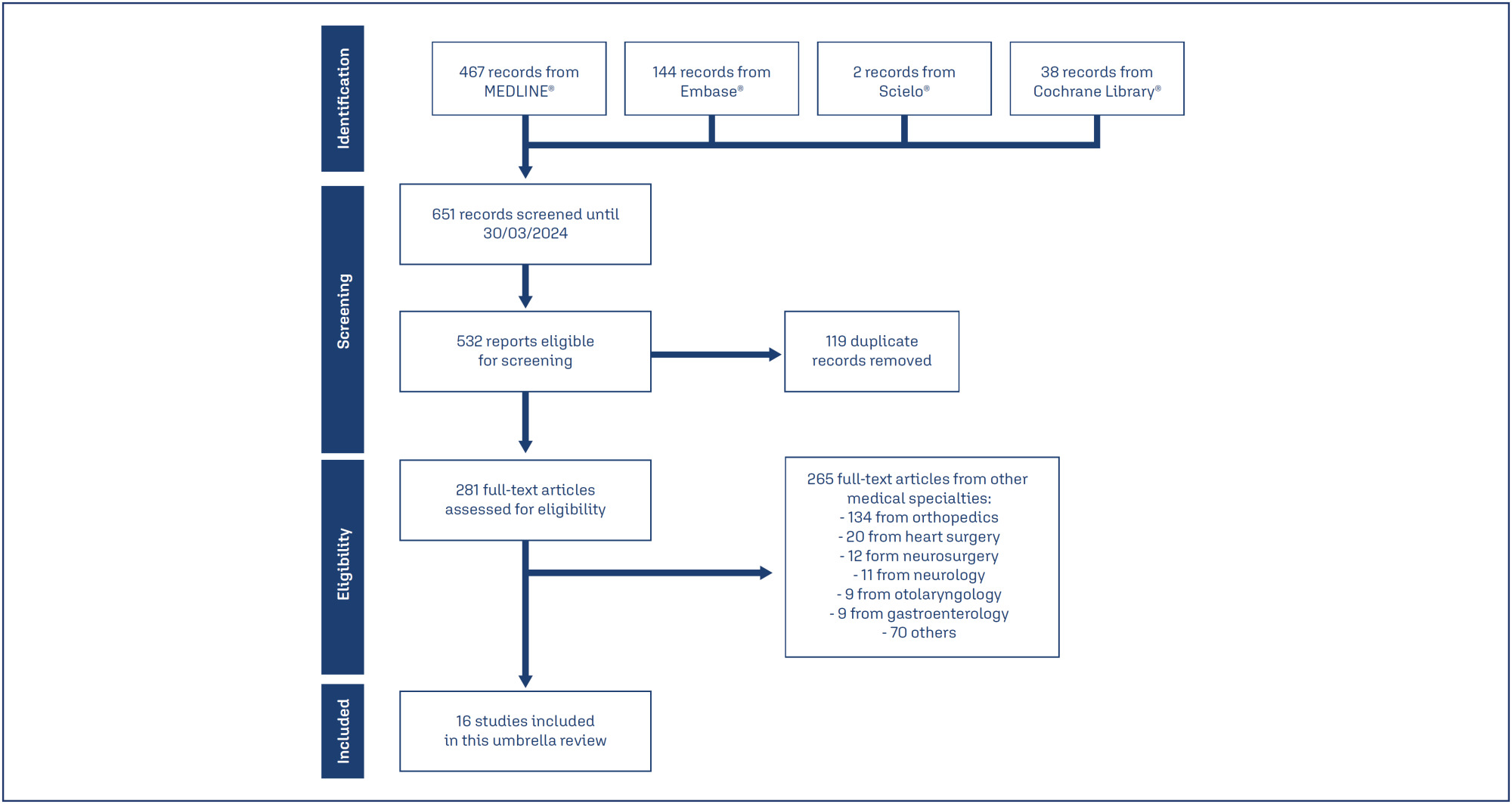
-
Original Article04-30-2025
Assessıng the predıctıve accuracy of blood-based bıomarkers ın neonatal outcomes for pregestatıonal dıabetes mellıtus
Revista Brasileira de Ginecologia e Obstetrícia. 2025;47:e-rbgo17
Abstract
Original ArticleAssessıng the predıctıve accuracy of blood-based bıomarkers ın neonatal outcomes for pregestatıonal dıabetes mellıtus
Revista Brasileira de Ginecologia e Obstetrícia. 2025;47:e-rbgo17
Views181Abstract
Objective:
This retrospective study aimed to investigate blood-based immune-inflammatory biomarkers (IIBs) in predicting neonatal outcomes in pregnancies with pregestational diabetes mellitus (PGDM).PIV[(neutrophil×platelet×monocyte)/lymphocyte)], SII (neutrophil×platelet/lymphocyte), and NLR neutrophil/lymphocyte) values were evaluated in all three trimesters, and their correlation with neonatal outcomes was examined.
Methods:
We included 82 cases of PGDM pregnancies delivered after 32 weeks. Maternal age, gravidity, parity, types of diabetes, and route of delivery were noted. For neonatal outcomes, we recorded gestational age at birth, birth weight percentile, existence of fetal growth restriction, LGA, neonatal intensive care unit (NICU) requirement, Apgar Score <7 at 1, 5, or 10 minutes, need for positive pressure ventilation (PPV), need for mechanical ventilation, hypoglycaemia, hyperbilirubinemia and the need for phototherapy. PIV, SII and NLR values were calculated in each trimester and their association with adverse neonatal outcomes was analyzed.
Results:
We could not detect any consistent and significant correlation between SII and PIV values and adverse neonatal outcomes for each trimester. There was a correlation between 3rd trimester NLR and adverse neonatal outcomes, including APGAR <7, the requirement for PPV and mechanical ventilation (p=0.056, 0.013 and 0.060, respectively).
Conclusion:
While SII and PIV values did not consistently correlate with adverse neonatal outcomes throughout each trimester in PGDM pregnancies, 3rd-trimester NLR showed a notable association with the requirement for PPV with statistical significance and with Apgar Score <7 and the requirement for mechanical ventilation without statistical significance. NLR in the third trimester may hold potential as a predictive marker for specific adverse neonatal outcomes in PGDM pregnancies, warranting further investigation.
Key-words biomarkersDiabetes mellitusGestational ageHypoglycemiaInfant, newbornIntensive care units, neonatalLymphocytesMaternal ageMonocytesNeuthrophilsPregancyPregnancy in diabetesRespiration, artificialSee more -
Original Article04-30-2025
Effects of domestic violence on menopausal symptoms, sexual function, and quality of life: a cross-sectional study
Revista Brasileira de Ginecologia e Obstetrícia. 2025;47:e-rbgo16
Abstract
Original ArticleEffects of domestic violence on menopausal symptoms, sexual function, and quality of life: a cross-sectional study
Revista Brasileira de Ginecologia e Obstetrícia. 2025;47:e-rbgo16
Views176Abstract
Objective:
To investigate the association between lifetime experience of domestic violence and climacteric symptoms, sexual function, and quality of life in climacteric women in Rio Grande do Sul, Brazil.
Methods:
A cross-sectional study was conducted with 700 pre-, peri-, and postmenopausal women, recruited online via an anonymous questionnaire (REDCap platform). Women aged 40 to 65 years, residing in Rio Grande do Sul, and classified by the STRAW+10 criteria were included. Climacteric symptoms and sexual function were assessed using the 10-item Cervantes Scale (CS-10) and the 6-item Female Sexual Function Index (FSFI-6). Data were analyzed using SPSS version 18.0; quantitative data as median [IQR], qualitative as frequencies. Group comparisons used Kruskal-Wallis, Chi-Square, and Spearman’s correlation between violence against women (VAW) and/or climacteric groups on CS-10 or FSFI-6. Significance was set at 5%.
Results:
The median [IQR] age of pre- (46 [43 – 50] years), peri- (50 [47 – 52] years), and postmenopausal (55 [51 – 58] years) were different among groups. Prevalence rates of psychological (38.8%), sexual (34.9%), and physical (21.3%) violence were observed. Postmenopausal women showed the poorest outcomes. Premenopausal women experiencing violence had severe anxiety, while postmenopausal women reported feeling worthless. Various sexual dysfunctions were associated with violence, including low desire, lubrication issues, and sexual pain.
Conclusions:
Domestic violence was linked to worse climacteric symptoms, sexual function, and quality of life, particularly in postmenopausal women. These findings underscore the need for improved care and public policies to enhance safety and well-being among women of all ages.
Key-words AnxietyClimactericDomestic violenceMenopausePostmenopauseQuality of lifeSexualitysurveys and questionnairesViolence against womenSee more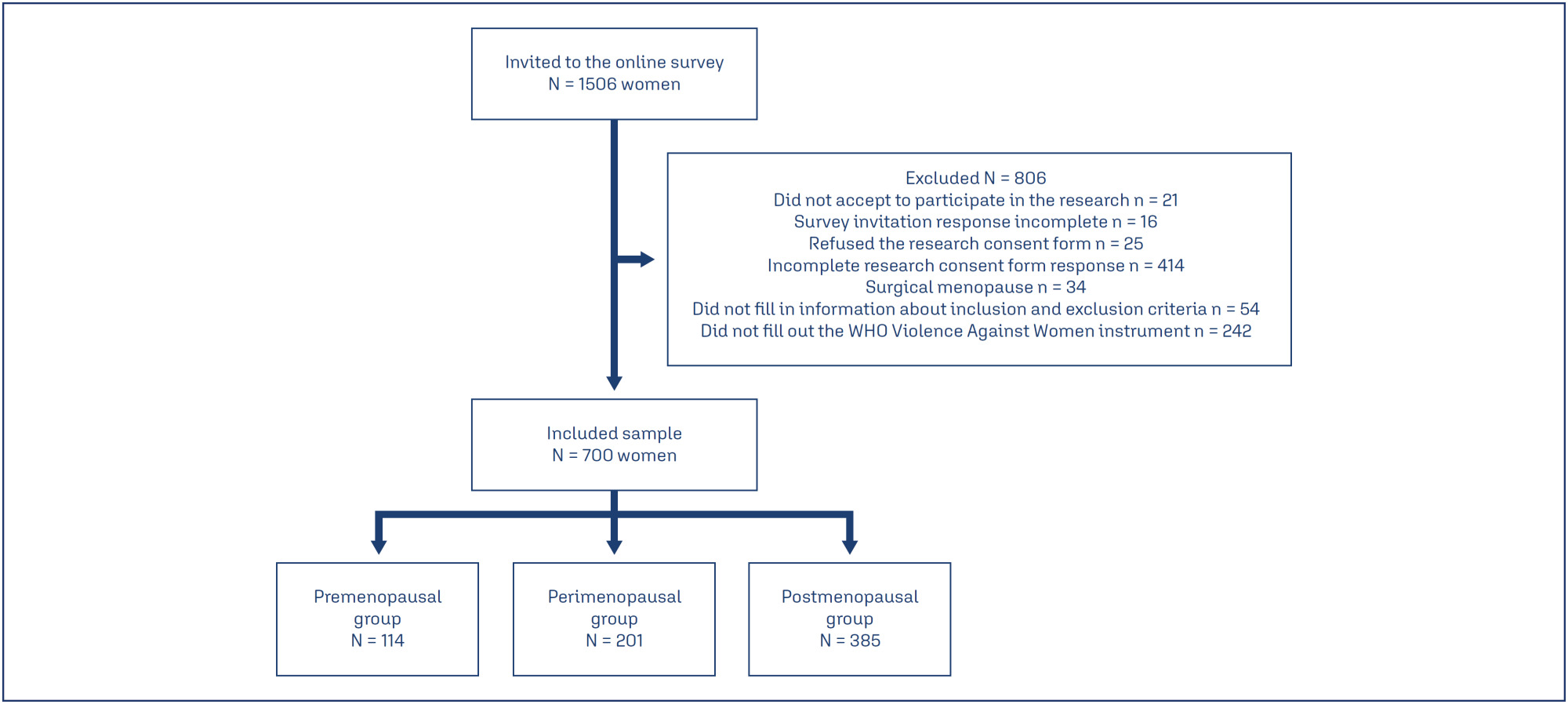
-
Original Article04-30-2025
The ımpact of demographic and obstetric factors on perception of traumatic birth and breastfeeding attitudes
Revista Brasileira de Ginecologia e Obstetrícia. 2025;47:e-rbgo15
Abstract
Original ArticleThe ımpact of demographic and obstetric factors on perception of traumatic birth and breastfeeding attitudes
Revista Brasileira de Ginecologia e Obstetrícia. 2025;47:e-rbgo15
Views144Abstract
Objective:
This study aims to examine the effects of sociodemographic and obstetric factors on traumatic birth perception and breastfeeding attitudes in primiparous mothers who have had a vaginal birth in the early postpartum period.
Methods:
The sample of the research, developed with a cross-sectional and correlational design, consisted of 252 women residing in a province in the Western Black Sea region of Türkiye. The data were obtained by employing a Personal Information Form, Traumatic Childbirth Perception Scale, and Breastfeeding Attitudes of The Evaluation Scale. Data analysis was conducted using the statistical programming language R (R version 4.3.3).
Results:
Women who were not employed, had a planned pregnancy, and did not experience health problems during pregnancy had higher mean breastfeeding attitude scores, and this difference was statistically significant. It was determined that a one-unit increase in gestational week led to an average increase of 1.926 units in breastfeeding attitude score, and a one-unit increase in Traumatic Childbirth Perception Scale score led to an average decrease of 0.110 units in breastfeeding attitude score. The mean traumatic childbirth perception scores of women living in urban areas were found to be lower than those living in villages or towns, and the difference was statistically significant.
Conclusion:
The research findings indicate that gestational age, perception of traumatic childbirth, and certain sociodemographic factors significantly affect breastfeeding attitudes. Additionally, mothers living in urban areas have a lower perception of traumatic childbirth. Therefore, individualized approaches to childbirth and breastfeeding support are crucial.
Key-words Breast feedingDelivery, obstetricParturitionperceptionPostpartum periodSociodemographic factorsStress disorders, post-traumaticSee more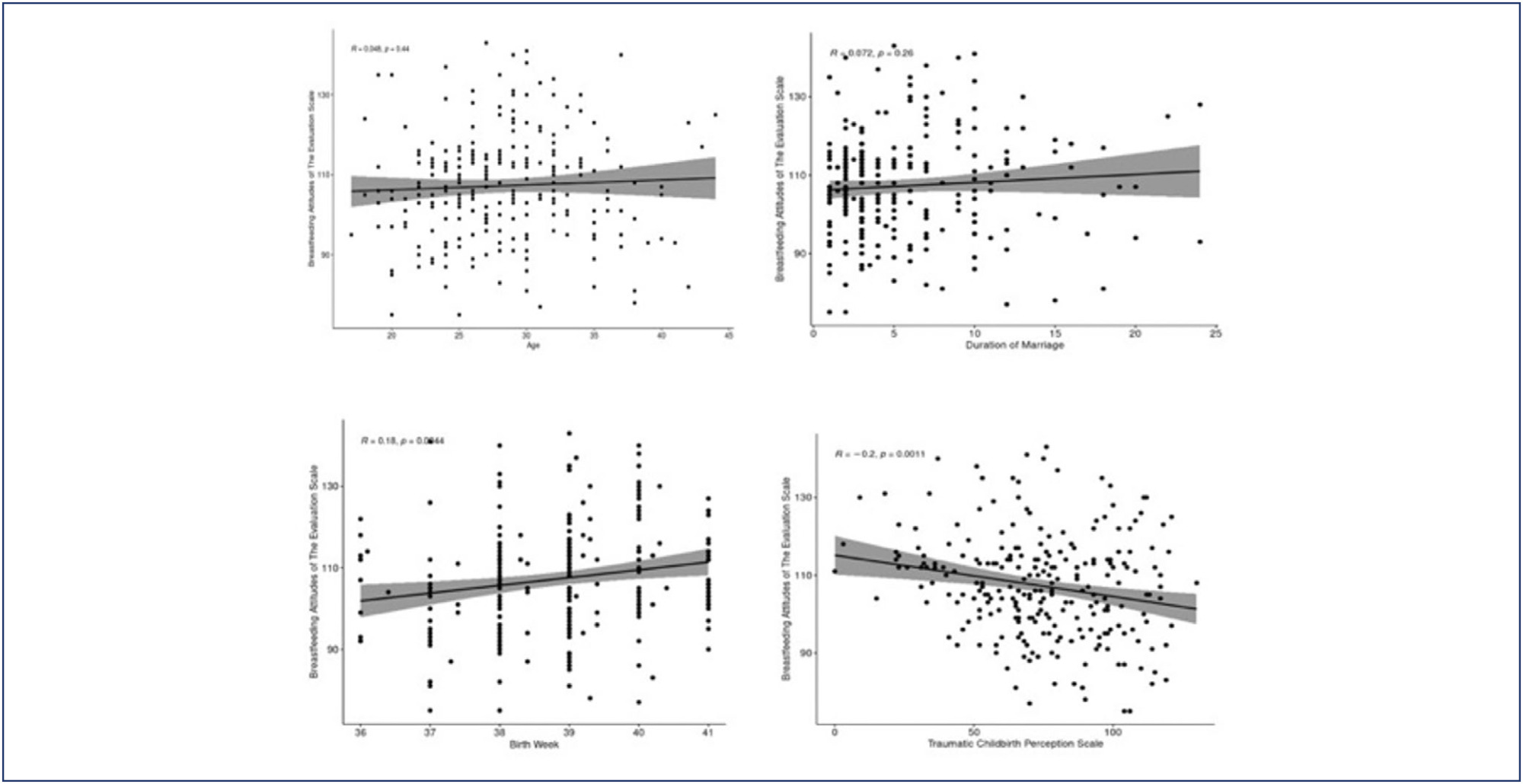
-
Original Article04-30-2025
Clinical and epidemiological profile of pregnant and postpartum women affected by COVID-19 who required respiratory support
Revista Brasileira de Ginecologia e Obstetrícia. 2025;47:e-rbgo14
Abstract
Original ArticleClinical and epidemiological profile of pregnant and postpartum women affected by COVID-19 who required respiratory support
Revista Brasileira de Ginecologia e Obstetrícia. 2025;47:e-rbgo14
Views150Abstract
Objective:
This study described the clinical and epidemiological profile and the management provided to pregnant and postpartum women with COVID-19 who required respiratory support.
Methods:
A descriptive study was conducted with pregnant and postpartum women with confirmed COVID-19 who received care between April 2020 and December 2021 in eight referral centers in northeastern Brazil. Statistical analysis was conducted using Epi-Info 7.2.5 and Medcalc, version 20.112.
Results:
Of the 720 patients admitted, 208 (32.7%) required respiratory support. Mean age of the participants was 28.9±7.1 years. Most (52.8%) were brown-skinned; 31.3% had little formal schooling; 41.1% had a personal income and 23.1% were married. Around half were referred from another hospital. Overall, 36.8% were obese and 36.9% were hypertensive. Criteria for severe acute respiratory syndrome (SARS) were present in 80.7% of cases. Overall, 151 patients (74.7%) required corticoids, and 150 (76.1%) were admitted to an intensive care unit. Non-invasive ventilation was needed in 89.4% of cases, with nasal catheters being the most common type (55.3% of cases). Invasive mechanical ventilation was necessary in 35.5% of cases and 91.6% had a cesarean section. Maternal near miss and death occurred in 24% and 12.9% of cases, respectively.
Conclusion:
Pregnant and postpartum women with COVID-19 who required respiratory support were predominantly brown-skinned, in the third trimester of pregnancy and had been referred from another hospital. The cesarean section rate was high; the presence of criteria for SARS was common and the rates of COVID-19-related maternal near miss and death were high.
Clinical Trials registry:
NCT04462367
Key-words Cesarian sectionCOVID-19Intensive care unitsNear miss, healthcareNoninvasive ventilationObesityPostpartum periodPregnancyPregnancy trimester, thirdRespiration, artificialSARS-CoV-2severe acute respiratory syndromeSee more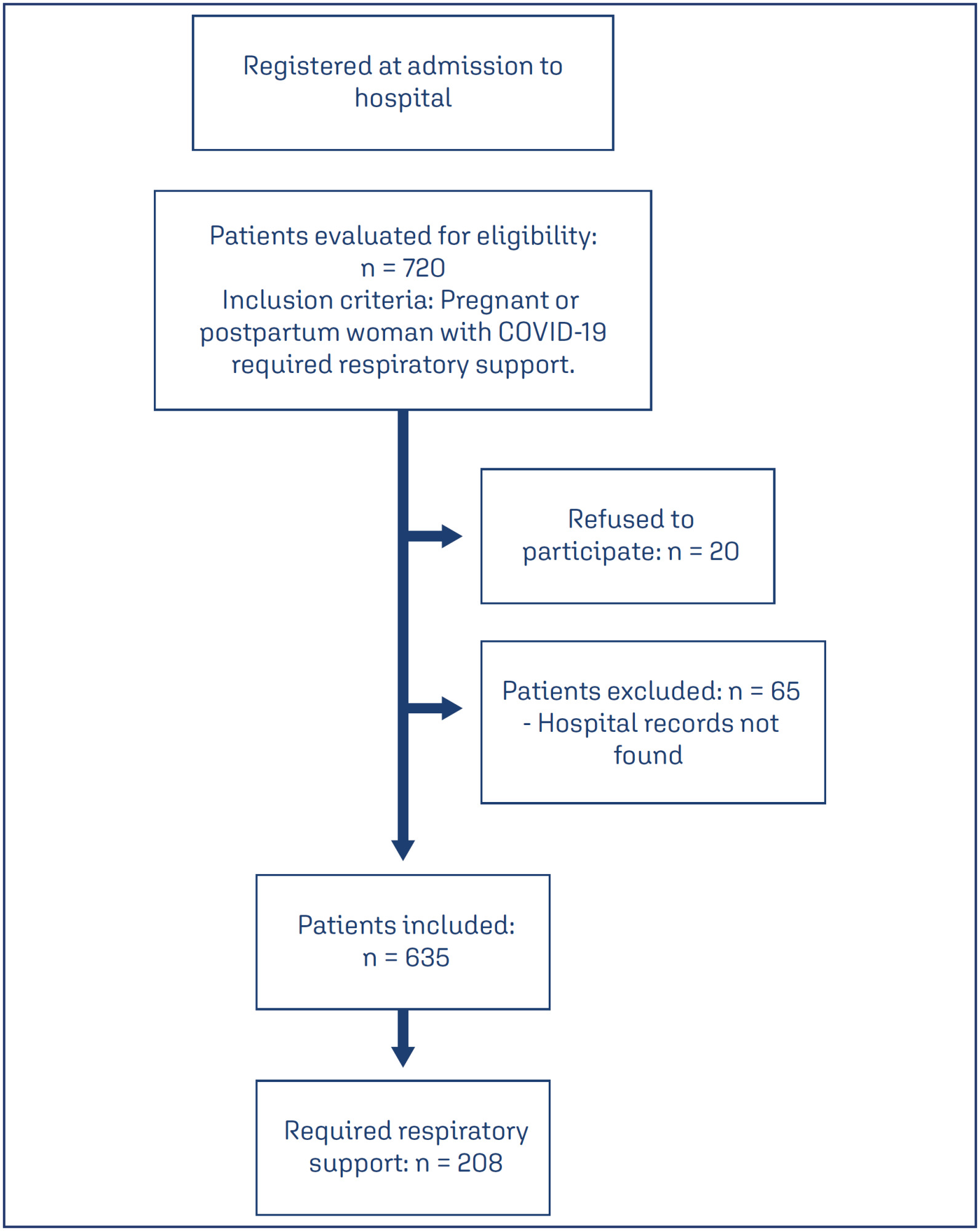
-
Original Article04-15-2019
Association between Dietary Glycemic Index and Excess Weight in Pregnant Women in the First Trimester of Pregnancy
Revista Brasileira de Ginecologia e Obstetrícia. 2019;41(1):04-10
Abstract
Original ArticleAssociation between Dietary Glycemic Index and Excess Weight in Pregnant Women in the First Trimester of Pregnancy
Revista Brasileira de Ginecologia e Obstetrícia. 2019;41(1):04-10
Views210See moreAbstract
Objective
To assess the association between dietary glycemic index (GI) and excess weight in pregnant women in the first trimester of pregnancy.
Methods
A cross-sectional study in a sample of 217 pregnant women was conducted at the maternal-fetal outpatient clinic of the Hospital Geral de Fortaleza, Fortaleza, state of Ceará, Brazil, for routine ultrasound examinations in the period between 11 and 13 weeks + 6 days of gestation.Weight and height were measured and the gestational body mass index (BMI) was calculated. The women were questioned about their usual body weight prior to the gestation, considering the prepregnancy weight. The dietary GI and the glycemic load (GL) of their diets were calculated and split into tertiles. Analysis of variance (ANOVA) or Kruskal-Walls and chi-squared (χ2) statistical tests were employed. A crude logistic regression model and a model adjusted for confounding variables known to influence biological outcomes were constructed. A p-value < 0.05 was considered significant for all tests employed.
Results
The sample group presented a high percentage of prepregnancy and gestational overweight (39.7% and 40.1%, respectively). InthetertilewiththehigherGIvalue, therewasa lower dietary intake of total fibers (p = 0.005) and of soluble fibers (p = 0.008). In the third tertile, the dietary GI was associated with overweight in pregnant women in the first trimester of gestation, both in the crude model and in the model adjusted for age, total energy intake, and saturated fatty acids. However, this association was not observed in relation to the GL.
Conclusion
A high dietary GI was associated with excess weight in women in the first trimester of pregnancy.
-
Original Article10-23-2024
Validation of Brazilian Version of the Sexual Desire Inventory 2 (SDI-2)
Revista Brasileira de Ginecologia e Obstetrícia. 2024;46:e-rbgo78
Abstract
Original ArticleValidation of Brazilian Version of the Sexual Desire Inventory 2 (SDI-2)
Revista Brasileira de Ginecologia e Obstetrícia. 2024;46:e-rbgo78
Views307ABSTRACT
Objective:
To traslate and validate of the Brazilian version of the SDI-2.
Methods:
This was a cross-sectional study. The cultural adaptation considered the stages of initial translation, synthesis of translations, evaluation by a committee of experts from different regions of Brazil, back-translation, and pre-test. The content validity and psychometric proprieties was assessed.
Results:
Ten specialists participated in the cultural adaptation of the SDI-2. The content validity showed a Content Validity Ratio (CVR) ≥ 0.75 (p = 0.05). A total of 674 subjects participated in the field study. The Exploratory Factorial Analysis (EFA) presented factor loads ≥ 0.445, and commonalities ≥ 0.40; and two dimensions represented 77% of the total variance explained. The Confirmatory Factorial Analysis CFA presented X2/df = 4.265; the Root Mean Square Error of Approximation RMSEA = 0.110; the Non-Normed Fit Index NNFI = 0.946; the Comparative Fit Index (CFI) = 0.963; the Goodness of Fit Index GFI = 0.986; and the Adjusted Goodness of Fit Index AGFI = 0.979 for a two-factor model. The coefficient values for the total SDI-2 score were 0.91 for Cronbach’s alpha, 0.91 for McDonald’s Omega, and 0.97 for the Greatest Lower Bound GLB coefficients. The invariance between sexes was 0.01 for the ΔCFI and ΔRMSEA, showing model stability for these two populations.
Conclusion:
The Brazilian version of the SDI-2 is self-report, valid, reliable and invariant across sex.
Key-words cross cultural comparisonLibidoPsychometricsSexual behaviorSexual desiresurveys and questionnairesSee more -
Original Article05-01-2016
Molecular Subtypes of Breast Cancer Are Not Associated with the Clinical Under- or Overstaging of Breast Cancer
Revista Brasileira de Ginecologia e Obstetrícia. 2016;38(5):239-245
Abstract
Original ArticleMolecular Subtypes of Breast Cancer Are Not Associated with the Clinical Under- or Overstaging of Breast Cancer
Revista Brasileira de Ginecologia e Obstetrícia. 2016;38(5):239-245
Views207See moreAbstract
Purpose
to evaluate the agreement between the clinical and pathological stagings of breast cancer based on clinical and molecular features.
Methods
this was a cross-sectional study, in which clinical, epidemiological and pathological data were collected from 226 patients who underwent surgery at the Prof. Dr. José Aristodemo Pinotti Women’s Hospital (CAISM/Unicamp) from January 2008 to September 2010. Patients were staged clinically and pathologically, and were classified as: understaged, when the clinical staging was lower than the pathological staging; correctly staged, when the clinical staging was the same as the pathological one; and overstaged, when the clinical staging was greater than the pathological staging.
Results
understaged patients were younger (52.2 years; p < 0.01) and more symptomatic at diagnosis (p = 0.04) when compared with correctly or overstaged patients. Clinicopathological surrogate subtype, menopausal status, parity, hormone replace therapy and histology were not associated with differences in staging. Women under 57 years of age were clinically understaged mainly due to underestimation of T ( tumor staging) (p < 0.001), as were the premenopausal women (p < 0.01). Patients whose diagnosis was made due to clinical complaints, and not by screening, were clinically understaged due to underestimation of N (lymph nodes staging) (p < 0.001).
Conclusion
the study shows that the clinicopathological surrogate subtype is not associated with differences in staging, while younger women diagnosed because of clinical complaints tend to have their breast tumors understaged during clinical evaluation.
-
Original Article06-19-2019
Correlation of Cervical Cancer Mortality with Fertility, Access to Health Care and Socioeconomic Indicators
Revista Brasileira de Ginecologia e Obstetrícia. 2019;41(4):249-255
Abstract
Original ArticleCorrelation of Cervical Cancer Mortality with Fertility, Access to Health Care and Socioeconomic Indicators
Revista Brasileira de Ginecologia e Obstetrícia. 2019;41(4):249-255
Views209See moreAbstract
Objective
The present study aimed to examine which development indicators are correlated with cervical cancer (CC) mortality rates in Brazil.
Methods
This was an ecological study that correlatedmortality rates and indicators, such as human development index (HDI), gross domestic product (GDP) per capita, illiteracy rate, fertility rate, screening coverage, proportion of private health insurance use, density of physicians, and density of radiotherapy centers. Themortality rateswere obtained fromthe Brazilian national registry, while the indicators were based on official reports from the Ministry of Health. Univariate and multivariate linear regression was used.
Results
Among the states of Brazil, the average age-specific CC mortality rate from 2008 to 2012 varied from 4.6 to 22.9 per 100,000 women/year. In the univariate analysis, HDI, proportion of private health insurance use, density of physicians, and density of radiotherapy centers were inversely correlated with the mortality rates. Fertility rate was positively correlated with the mortality rates. In the multivariate analysis, only fertility rate was significantly associated with the CC mortality rate (coefficient of correlation: 9.38; 95% confidence interval [CI]: 5.16-13.59).
Conclusion
A decrease in the fertility rate, as expected when the level of development of the regions increases, is related to a decrease in the mortality rate of CC. The results of the present study can help to better monitor the quality assessment of CC programs both among and within countries.
-
Review Article08-15-2019
New Approaches to Fetal Growth Restriction: The Time for Metabolomics Has Come
Revista Brasileira de Ginecologia e Obstetrícia. 2019;41(7):454-462
Abstract
Review ArticleNew Approaches to Fetal Growth Restriction: The Time for Metabolomics Has Come
Revista Brasileira de Ginecologia e Obstetrícia. 2019;41(7):454-462
Views213See moreAbstract
Fetal growth restriction (FGR) diagnosis is often made by fetal biometric ultrasound measurements orDoppler evaluation, but most babies are only diagnosed after birth, using the birth weight as a proxy for intrauterine development. The higher risks of neurodevelopmental delay, metabolic syndrome, and cardiovascular illness associated with FGR impose a shift on the focus during pregnancy. New methodological approaches, like metabolomics, can provide novel biomarkers for intrauterine fetal development. Recent evidence on metabolites involved with fetal growth and weight show a consistent role played by lipids (especially fatty acids), amino acids, vitamin D and folic acid. Fetal energy source andmetabolism, structural functions, and nervous system functioning need further evaluations in different populations. In the near future, the establishment of a core set of outcomes for FGR studies may improve the identification of the role of each metabolite in its development. Thus, we will concretely progress with the perspective of a translational capacity of metabolomics for this condition.
-
FEBRASGO POSITION STATEMENT03-08-2021
Good practices for ultrasound examinations in gynecology and obstetrics during the COVID-19 pandemic
Revista Brasileira de Ginecologia e Obstetrícia. 2021;43(1):74-79
Abstract
FEBRASGO POSITION STATEMENTGood practices for ultrasound examinations in gynecology and obstetrics during the COVID-19 pandemic
Revista Brasileira de Ginecologia e Obstetrícia. 2021;43(1):74-79
-
FEBRASGO POSITION STATEMENT07-10-2023
Guidelines on how to monitor gestational weight gain during antenatal care: Number 2 – February 2023
Revista Brasileira de Ginecologia e Obstetrícia. 2023;45(2):104-108
Abstract
FEBRASGO POSITION STATEMENTGuidelines on how to monitor gestational weight gain during antenatal care: Number 2 – February 2023
Revista Brasileira de Ginecologia e Obstetrícia. 2023;45(2):104-108
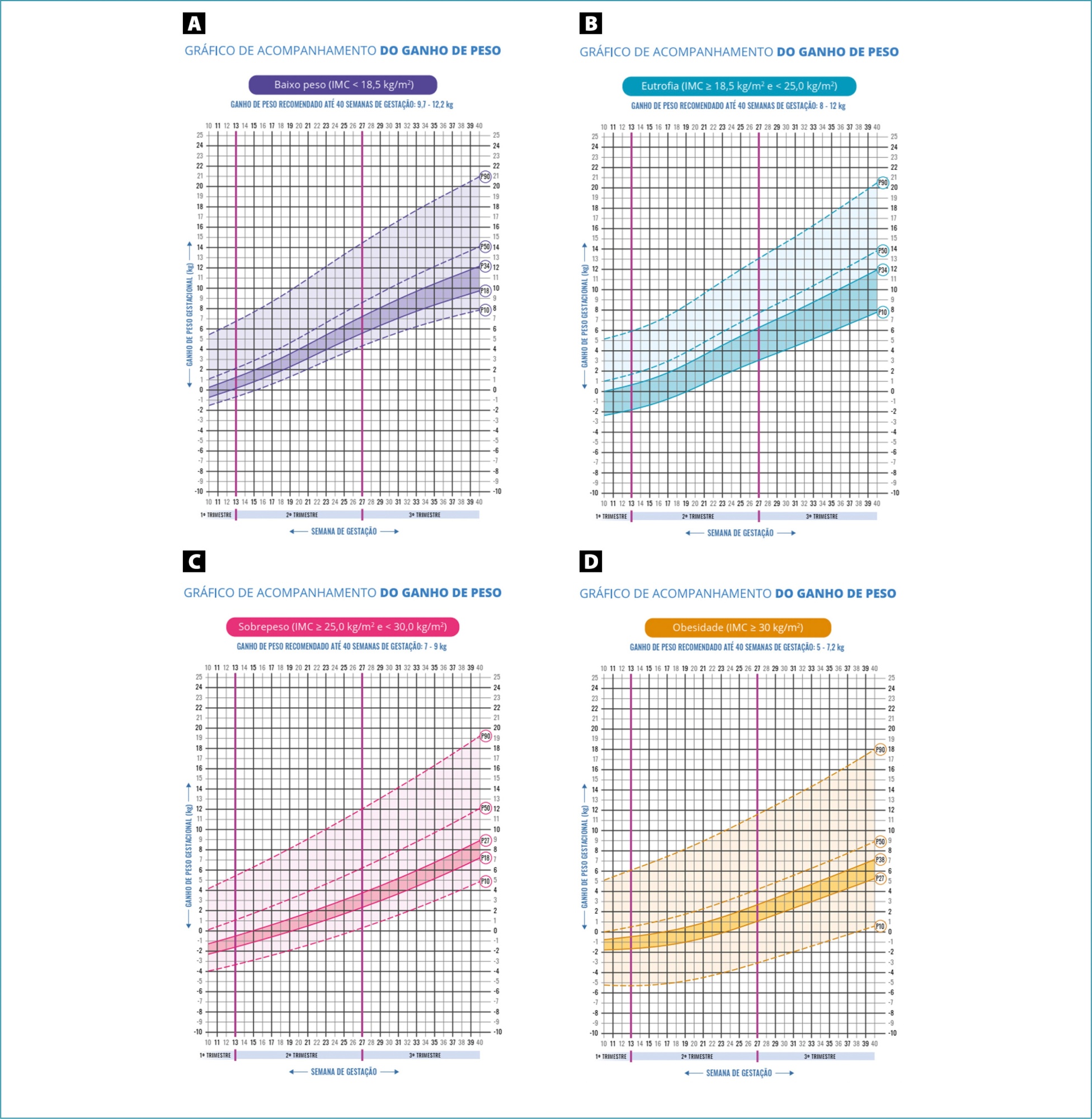
-
Review Article09-06-2024
Biochemical markers for prediction of the first half pregnancy losses: a review
Revista Brasileira de Ginecologia e Obstetrícia. 2024;46:e-rbgo72
Abstract
Review ArticleBiochemical markers for prediction of the first half pregnancy losses: a review
Revista Brasileira de Ginecologia e Obstetrícia. 2024;46:e-rbgo72
Views306Abstract
Objective
26% of all pregnancies end in miscarriage, and up to 10% of clinically diagnosed pregnancies, and recurrent pregnancy loss is 5% among couples of childbearing ages. Although there are several known causes of pregnancy loss in the first half, including recurrent pregnancy loss, including parental chromosomal abnormalities, uterine malformations, endocrinological disorders, and immunological abnormalities, about half of the cases of pregnancy loss in its first half remain unexplained.
Methods
The review includes observational controlled studies (case-control or cohort, longitudinal studies, reviews, meta-analyses), which include the study of biochemical factors for predicting pregnancy losses in the first half, in singlet pregnancy. The Newcastle-Ottawa Scale (NOS) was used to assess the research quality.
Results
Finally, 27 studies were included in the review, which has 134904 examined patients. The results of the review include estimates of β-human chorionic gonadotropin, progesterone, pregnancy-associated protein – A, angiogenic vascular factors, estradiol, α-fetoprotein, homocysteine and CA-125 as a predictors or markers of the first half pregnancy losses.
Conclusion
It may be concluded that to date, research data indicate the unavailability of any reliable biochemical marker for predicting pregnancy losses in its first half and require either a combination of them or comparison with clinical evidence. A fairly new model shall be considered for the assessment of α-fetoprotein in vaginal blood, which may have great prospects in predicting spontaneous miscarriages.
Key-words Biochemical markerLaboratory markerMiscarriagemissed abortionpredictionPregnancySpontaneous abortionSee more
Search
Search in:
Tag Cloud
Pregnancy (252)Breast neoplasms (104)Pregnancy complications (104)Risk factors (103)Menopause (88)Ultrasonography (83)Cesarean section (78)Prenatal care (71)Endometriosis (70)Obesity (61)Infertility (57)Quality of life (55)prenatal diagnosis (51)Women's health (48)Maternal mortality (46)Postpartum period (46)Pregnant women (45)Breast (44)Prevalence (43)Uterine cervical neoplasms (43)


